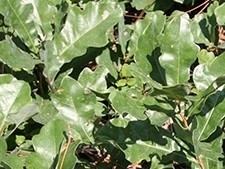Sand post oak
(Quercus lancifolia)

Description
Quercus margarettae, the sand post oak or dwarf post oak, is a North American species of oak in the beech family. It is native to the southeastern and south-central United States from Virginia to Florida and west as far as Texas and Oklahoma. There are historical reports of the species growing in New York State, but it has not been seen there in years. Quercus margarettae is a deciduous shrub or small tree growing up to 12 meters (40 feet) tall. The bark is gray and scaly. The leaves are up to 135 millimetres (5+1⁄4 inches) long, and bipinnately lobed with rounded lobes. The plant grows in sandy or gravelly soil. An oak is a tree or shrub in the genus Quercus ("oak tree") of the beech family, Fagaceae. There are approximately 500 extant species of oaks. The common name "oak" also appears in the names of species in related genera, notably Lithocarpus (stone oaks), as well as in those of unrelated species such as Grevillea robusta (silky oaks) and the Casuarinaceae (she-oaks). The genus Quercus is native to the Northern Hemisphere, and includes deciduous and evergreen species extending from cool temperate to tropical latitudes in the Americas, Asia, Europe, and North Africa. North America has the largest number of oak species, with approximately 160 species in Mexico of which 109 are endemic and about 90 in the United States. The second greatest area of oak diversity is China, with approximately 100 species. Oaks have spirally arranged leaves, with lobate margins in many species; some have serrated leaves or entire leaves with smooth margins. Many deciduous species are marcescent, not dropping dead leaves until spring. In spring, a single oak tree produces both male flowers (in the form of catkins) and small female flowers, meaning that the trees are monoecious. The fruit is a nut called an acorn or oak nut borne in a cup-like structure known as a cupule; each acorn contains one seed (rarely two or three) and takes 6–18 months to mature, depending on their species. The acorns and leaves contain tannic acid, which helps to guard from fungi and insects. The live oaks are distinguished for being evergreen, but are not actually a distinct group and instead are dispersed across the genus. Linnaeus described only five species of oak from eastern North America, based on general leaf form. These were white oak (Quercus alba), chestnut oak (Q. montana), red oak (Q. rubra), willow oak (Q. phellos), and water oak (Q. nigra).
Taxonomic tree:







